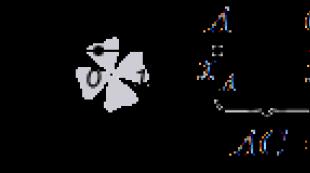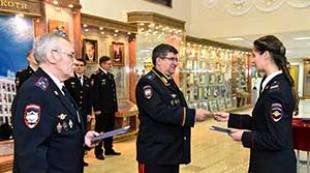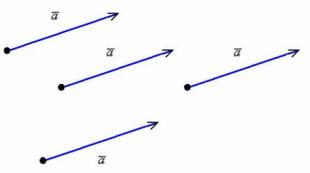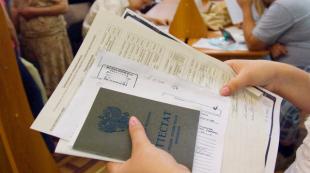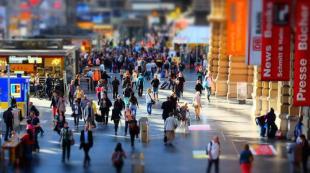The earthling was the first to go into outer space. Six facts about a space mission. What did Leonov feel?
On March 18, 1965, Soviet cosmonaut Alexei Arkhipovich Leonov made the first spacewalk in history.
This mission was the most important stage in the development of astronautics. The whole country was following her!
Alexey Arkhipovich Leonov was overboard spaceship"Voskhod-2", which started at 10:00 Moscow time. The ship's commander was Pavel Ivanovich Belyaev. The ship was equipped with an inflatable lock chamber "Volga". Before launch, it folded, and in space - inflated.
The spacewalk began on the second orbit. A. Leonov moved into the lock chamber and P. Belyaev closed the hatch behind him. Then the air from the chamber was bled. At 11:34:51 Alexei Leonov left the airlock and ended up in outer space.
The first thing he saw was the black sky. The astronaut's pulse was 164 beats per minute, the moment of exit was very tense.
P. Belyaev transmitted to Earth:
Attention! The man went into outer space!
The television image of Aleksey Arkhipovich Leonov soaring against the background of the Earth was broadcast on all television channels.
Telegraph agency Soviet Union reported:
- Today, March 18, 1965, at 11:30 Moscow time, during the flight of the Voskhod-2 spacecraft, a man's exit into outer space was carried out for the first time. On the second circuit of the flight, co-pilot pilot-cosmonaut Lieutenant Colonel Leonov Alexei Arkhipovich, in a special spacesuit with an autonomous life support system, made an exit into outer space, retired from the ship at a distance of up to five meters, successfully carried out a set of planned studies and observations and safely returned to the ship. With the help of the onboard television system, the process of Comrade Leonov's exit into outer space, his work outside the spacecraft, and his return to the spacecraft were transmitted to Earth and observed by a network of ground stations. The state of health of Comrade Alexei Arkhipovich Leonov during his stay outside the ship and after returning to the ship is good. The commander of the ship, comrade Pavel Ivanovich Belyaev, is also feeling well.
Alexey Arkhipovich Leonov spent 12 minutes 9 seconds outside the ship. In total, the first exit took 23 minutes 41 seconds. The Berkut space suit was specially designed for the exit. He provided a stay in outer space for 30 minutes.
Due to the pressure difference in space, the spacesuit swelled up and lost its flexibility. This greatly prevented the astronaut from entering the hatch to return to Voskhod-2. Several unsuccessful attempts were made, but in the end everything worked out. Later there were several more emergency situations. However, despite them, the flight ended successfully.
A. Leonov describes his impressions of what he saw in this way:
I want to tell you that the picture of the cosmic abyss that I saw, with its grandeur, immensity, brightness of colors and sharp contrasts of pure darkness with the dazzling radiance of the stars, simply struck and fascinated me. To complete the picture, imagine - against this background, I see our Soviet ship, illuminated by the bright light of the sun's rays. When I was leaving the gateway, I felt a powerful stream of light and heat, reminiscent of electric welding. Above me was a black sky and bright, unblinking stars. The sun seemed to me like a red-hot fiery disk ...
The first exit of man into outer space marked a new stage in the development of astronautics and science in general!
60s of the 20th century - the time of the peak " cold war» two superpowers: the US and the Soviet Union. The struggle is also being waged in the exploration of outer space. The first step is taken by the USSR, April 12, 1961 makes its first flight. The next step is the first man in outer space, who will take this height? Countries gave an answer to this question only after 4 years.
First man in outer space
The political and scientific battle was serious: Soviet cosmonauts and American astronauts made regular flights into outer space, but all the work was carried out inside the ship. And, finally, that historic day came when the USSR again took the lead. On March 18, 1965, the Soviet pilot-cosmonaut went into outer space.
The flight took place on the Voskhod-2 spacecraft. The commander was Leonov's partner -. Having reached orbit, the astronauts began to prepare. Aleksey Leonov put on a specially designed Berkut spacesuit, and Pavel Belyaev set about installing an airlock through which the exit was to take place. The chamber was cylindrical in shape and consisted of three compartments isolated from each other with 12 inflatable sections in each. When entering outer space, the lock chamber was depressurized.
 Spacecraft "Voskhod-2"
Spacecraft "Voskhod-2" As soon as the astronaut found himself in a vacuum inside the compartments, the countdown of his stay outside the ship began. The end of the spacewalk is considered to be the time when the airlock hatch was closed. Thus, the first spacewalk of Alexei Leonov lasted 23 minutes 41 seconds. He spent 12 minutes and 9 seconds completely out of the ship and camera. During this time, Leonov 5 times moved away from the ship and approached it. It was attached to Voskhod-2 with a special 5.35 m long halyard.

But not everything was so rosy. The Berkut suit was of a ventilation type with a total oxygen supply of 1666 liters. The air consumption per minute was 30-35 liters, depending on the astronaut's breathing rate, i.e. The supply of oxygen would be enough for a maximum of 45 minutes. When cosmonaut Leonov went out into open space, due to the difference in pressure, the spacesuit inflated. Returning to the ship, he realized that he could not pass through the lock, the inner diameter of which was only 1 meter.
At first, Alexei Leonov wanted to report what had happened to the headquarters on Earth, but decided not to waste precious time on this, because such situations had never arisen before, simply because he was the first cosmonaut to go into open space. Leonov made a decision that saved his life - he began to bleed oxygen from the spacesuit, thereby blowing it off. Gradually, the astronaut nevertheless returned back to the ship.

It was a victory! But, as always, trouble does not come alone. At first, Voskhod-2's orientation system failed, and Belyaev and Leonov had to steer the ship manually. Then, upon entering the Earth's atmosphere, the orbital module did not separate from the landing module. And until the connecting cable burned out, the astronauts rotated, experiencing an overload of up to 10G.
Due to all the technical difficulties, the landing took place far from the intended place. The team landed in the deep snowy taiga, 200 km north of Perm. At night the temperature reached -30 degrees. Rescuers reached the heroes only after 2 days.

It was a historic moment not only for the USSR, but for the whole world. The main pages of all newspapers were full of photos and stories about the achievements of Soviet cosmonauts Alexei Leonov and Pavel Belyaev. Both were awarded the title of Hero of the Soviet Union. In 2017, Alexei Arkhipovich Leonov turned 83 years old. He lives in Moscow. All his life, until his retirement, he devoted to cosmonautics, and also became an artist: together with the science fiction writer A. Sokolov, he created a series of postage stamps on the theme “The History of Space”. Unfortunately, Pavel Belyaev died in 1970 from an illness. He was only 44 years old.
First American in outer space
The Americans lagged behind the USSR by 2.5 months. The first spacewalk by a US astronaut took place on June 3, 1965. It was NASA astronaut Air Force Lieutenant Colonel Edward White. The flight was made on the Gemini-4 spacecraft. A ship of this type did not have an airlock, so depressurization of the entire ship was required to enter the open space.

The Americans considered the beginning of the spacewalk the moment when the astronaut's head protruded beyond the spacecraft, even if the rest of the body was still inside. The end of the spacewalk was the moment when the astronaut was completely inside Gemini 4. Thus, Edward White spent 36 minutes in outer space. 2 years after this event, at the age of 36, the astronaut died in a fire during the test of the Apollo 1 spacecraft and was posthumously awarded the NASA Distinguished Service Medal.

Since then, astronauts have regularly made spacewalks to get work done outside the spacecraft. Of course, such activity is risky. First of all, space debris poses a danger, a collision with which can cost the astronaut life or seriously damage the spacesuit. Dangerous and unintentional removal from the ship. To secure the work of space workers, scientists are working on the creation of robots that can perform actions outside the spacecraft without human intervention.

In astronautics, our country has always occupied a leading position: the first flight into space, the first spacewalk, the launch of the first artificial satellite Earth and the first artificial satellite of the Sun, even the launch of the first animal into space - the dog Laika. All this is our history and our pride!
In 2017, in memory of the feat of Alexei Leonov and Pavel Belyaev, Feature Film, based on real events, - "The Time of the First". The main roles in it were played by and. In the film, you can see not only the technical facts of the flight itself and its preparation, but also the personal experiences of the characters and their families. And once again admire the heroism and courage of the great cosmonauts who made an invaluable contribution to space exploration.
50 years ago, Alexei Leonov was the first in history to go into the airless space.
Half a century ago, on March 18, 1965, Soviet cosmonaut Alexei Leonov made the first human spacewalk in history.
The experiment was planned as part of the expedition of the Voskhod-2 spacecraft, which launched on the same Thursday from the Baikonur cosmodrome in the Kazakh SSR. The crew of the ship was commander Pavel Belyaev and pilot Alexei Leonov. On the occasion of the anniversary, "360 Podmoskovye" prepared five interesting facts about this momentous event.

Too much radiation
Even during the launch of the spacecraft (SC) into orbit, problems began. The fact is that Voskhod-2, due to a technical error, moved away from the Earth by 495 kilometers instead of 350 kilometers, as planned. At the same time, the radiation layer, which is detrimental to humans, is located at a distance of 500 kilometers from the Planet.
The dose of radiation received by the cosmonauts was 70 billion rad, which is almost two times higher than during the Voskhod-1 expedition. If at that moment high-intensity solar wind streams passed near the Earth, the astronauts could die.

The main thing is that the suit sits
To enter the airless space, OKB-1 employees developed the Berkut spacesuit, which, unlike modern extravehicular suits, did not allow regenerating the air exhaled by the astronaut. In the "Berkut", designed for a 30-minute stay in outer space, Alexei Leonov five times moved away from the spacecraft "Voskhod-2" at a distance of up to 5.35 meters.
However, when the astronaut wanted to return to the airlock, he realized that due to the pressure difference, the spacesuit was inflated. Leonov had to, risking his life, reduce the pressure inside the Berkut and, violating safety rules, get into the airlock head first. As a result, the astronaut still managed to return to the spacecraft.

CCTV
Leonov spent 23 minutes and 41 seconds in vacuum. The historical event was observed by video cameras installed on the outer surface of the Voskhod-2 spacecraft. The image from them was transmitted to the Earth, in addition, the cosmonaut himself also filmed video using the S-97 camera. 
Rough landing
During the return of the spacecraft to the Planet on March 19, the spacecraft's automatic landing system failed, so the cosmonauts had to land Voskhod-2 manually. The landing was carried out in an unplanned place - in the taiga, 180 kilometers from Perm. Pavel Belyaev and Alexei Leonov were discovered only four hours later, and the heroes were evacuated only two days later, and the astronauts had to use skis to get to the helicopter landing pad.

space race
Domestic cosmonauts managed to overtake the American astronauts at this checkpoint of the space race. US Representative Edward White did the first spacewalk on June 3, 1965. Apparently, because of this, the phrase "Triumph of the country of the Soviets" was printed on Soviet postage stamps dedicated to the feat of Pavel Belyaev and Alexei Leonov.

Since the first human spacewalk, 729 walks in airless outer space have been made with a total duration of more than four thousand hours. Soviet cosmonaut Svetlana Savitskaya stepped outside her spacecraft on July 25, 1984, becoming the first woman to walk in outer space. In total, 210 people visited the airless space. The record holder for the number of spacewalks is Anatoly Solovyov - he has 16 of them with a total duration of more than 78 hours.
On the death of cosmonaut Alexei Leonov. He became the first man to go into outer space. This happened 54 years ago, during the flight of the Voskhod-2 spacecraft on March 18-19, 1965.
Ship "Voskhod-2"
To enter the airless space, the specialists of OKB-1 (now the Rocket and Space Corporation Energia named after S.P. Korolev; Korolev, Moscow Region) the three-seater Voskhod ship was converted into a two-seater to make room for putting on a spacesuit and organization of the entrance to the lock chamber.
The suit for extravehicular activities "Berkut" and the lock chamber "Volga" for access to space were developed by the design bureau of the experimental plant number 918 in the village near Moscow. Tomilino (now - Research and Production Enterprise "Zvezda") under the leadership of the chief designer Guy Severin (1926-2008). The Berkut was a ventilating spacesuit, that is, it did not allow regenerating the air exhaled by the astronaut, as in modern spacesuits, and was designed for a 20-30-minute stay in space (total weight - 100 kg). The lock chamber in working order had the shape of a cylinder 2.5 m long, with an outer diameter of 1.2 m and an inner diameter of 1 m. It was inflatable and was located outside the ship's hull. Before entering orbit, the camera was placed in a folded form under the Vostok-2 fairing, and before descending to Earth, its main part was separated from the spacecraft. In case of an emergency, the lock chamber had a backup oxygen system, connected to the spacesuit with a special cable (7 m). In addition, additional emergency oxygen cylinders with a total capacity of about 4 liters were attached to the spacesuit behind the cosmonaut's back (they should have been enough for 20 minutes).
Flight and spacewalk
The ship "Voskhod-2" with Alexei Leonov (co-pilot) and Pavel Belyaev (commander) was launched from the Baikonur Cosmodrome on March 18, 1965 (10:00 Moscow time). When the spacecraft was making its first orbit around the Earth, the lock chamber was inflated, and on the second orbit Alexei Leonov's exit into space began. The cosmonaut moved away from the ship five times at a distance of up to 5.35 m. A safety cable was used to supply oxygen and communicate with the Voskhod-2 board (orbit parameters - from 167 km to 475 km).
The exit was not without contingencies. Due to the pressure difference, the spacesuit inflated. This prevented the astronaut from returning to the lock chamber (the diameter of the hatch was critically small). Therefore, Leonov, risking his life, was forced to bleed the pressure in the spacesuit to almost critical pressure (from 0.4 to 0.27 atmospheres). In violation of the instructions, the cosmonaut had to enter the airlock head first, and to close the hatch behind him he had to roll over in a tight space (from the story of Alexei Leonov in the book "World Manned Cosmonautics: History. Technique. People", 2005).
The total time spent by Alexei Leonov in the airless space was 23 minutes. 41 sec., of which 12 min. 9 sec. - outside the ship (in free flight). Two television cameras were installed on the outer surface of the ship, which transmitted the image to Earth. In addition, the cosmonaut himself filmed with a special S-97 film camera.
The total duration of the Voskhod-2 flight was 1 day 2 hours 2 minutes.
Landing, record registration
When the cosmonauts returned to Earth on March 19, the spacecraft's automatic orientation system failed, and the landing was carried out manually. The crew landed in an off-design area - 180 km north of Perm, far from settlements. The astronauts were discovered four hours later in the taiga, but due to deep snow they were evacuated only two days later.
On October 20, 1965, the International Aeronautical Federation (FAI) approved the world record for the duration of a person's stay in outer space outside a spacecraft - 12 minutes. 9 sec. For the first spacewalk in the history of mankind, the FAI awarded Alexei Leonov its highest award - the Cosmos Gold Medal, and Pavel Belyaev was awarded a federation diploma and medal.
Alexei Leonov is the first cosmonaut to go into outer space.
Cosmonaut Alexei Leonov
Out in outer space
March 1965 is forever imprinted not only in the history of Russian cosmonautics. The 18th day of this month was hardly a less glorious milestone for the entire earthly civilization on the path to conquering space than the Gagarin flight:
Alexei Leonov, USSR cosmonaut number 11, left the airlock of the spacecraft, made a spacewalk. For the successful completion of his mission, Leonov was awarded the title of Hero of the Soviet Union. It is difficult to overestimate the achievements of those years in the field of peaceful space exploration, because that was the time of the first.
Biography of cosmonaut Alexei Leonov
On the penultimate day of May 1934, the Leonov family, who then chose a small Siberian settlement as their place of permanent residence, was replenished with another child, who was named Alexei. The head of the family, Arkhip Leonov, moved to Siberia from Ukraine after the end of the Civil War, following his father, who was sent into exile by the tsarist government back in 1905.

The wave of mass repressions and political persecution that swept across the country in 1937-1938 also affected the Leonov family: the entire family was declared “enemies of the people” and deprived of their homes. A temporary shelter was found in the regional center - the city of Kemerovo. After the rehabilitation of 1939, the Leonovs moved to Kaliningrad, where the father of the family was offered a job in his profile (electrician).
Alexei Leonov, being an extremely inquisitive child, had diverse hobbies: fencing, athletics, technical sciences, plumbing, painting. In almost all sports areas, he has achieved serious success, confirmed by the relevant categories. In 1953, having received a secondary general education, Alexey decided to go to the Kremenchug aviation school. Then the young pilot continued his studies at the Military Aviation School in the city of Chuguev, Kharkov region.

On March 18, 1965, having been selected for the team of the first cosmonauts, Alexei Leonov took a direct part in the flight beyond the earth's atmosphere, which lasted a little over 2 hours. Cosmonaut Pavel Belyaev became his partner. During this event, Leonov filmed a video while outside the Voskhod-2 spacecraft for a little more than 12 minutes.
After this significant event, cosmonaut A. Leonov participated in the preparation of programs for the exploration of the moon, which were subsequently curtailed due to the loss of the USSR championship in " moon race with the United States.
Aleksey Arkhipovich always strived to have the most up-to-date knowledge in the technical field: in parallel with his main job, he received additional education at the N. E. Zhukovsky Air Force Academy.
In 1971, Leonov was given command of the crew of the Soyuz-11 spacecraft. In 1975, he flew into Earth orbit together with cosmonaut Valery Kubasov on the Soyuz-19 spacecraft. At the same time, the first docking with an American spacecraft was made.
From 1976 to 1991, Alexei Arkhipovich Leonov worked at the Cosmonaut Training Center. In 1992, he retired with the rank of Major General of Aviation. Since then he lives in Moscow, leads scientific activity related to ensuring the safety of space flights. The choice of this vector of research may be due to the problems that Alexei Leonov had to face during the flight on the Voskhod-2 spacecraft
Voskhod-2
The feat of Yuri Gagarin was the first step on the difficult path of exploration of near-Earth space. The astronaut's spacewalk was the next mission, technical support which involved advanced Soviet enterprises. The Berkut spacesuit was developed at the Zvezda Research and Production Enterprise taking into account the specifics of the planned event: its purpose was not only to ensure safety during spacewalks, but to save the astronaut in the event of a depressurization of the spacecraft. Having passed the required preparatory procedures, the crew of two (Pavel Belyaev and Alexei Leonov) went into orbit on March 18, 1965 at 10:00 Moscow time. Everything was running normally. Having made two orbits around the planet, the cosmonauts decided that Leonov would leave the spacecraft. At 11:34 he, having passed the lock chamber, found himself in an airless space, where he stayed for 12 minutes. When we returned, the problems began.

Difficult return
For safety reasons, the astronaut kept in touch with the spacecraft via a 5-meter connecting cord. According to Leonov, staying in the vacuum of space was overshadowed by severe physical discomfort (tachycardia, shortness of breath, increased sweating, fever). Trying to return to the airlock, Aleksey ran into a problem that could not even be imagined during the preparation of the flight: the spacesuit was swollen and did not allow the astronaut to get on the ship. The entrance to the airlock became possible only after the pressure was released from the suit. Not having time to take a breath after such a test, the astronauts received a signal about the depressurization of the ship: after the regular disconnection of the airlock, the hatch was damaged and did not fit snugly into the grooves. By turning on the oxygen supply from spare tanks, Leonov managed to put an end to this problem. But a new one was already looming on the horizon: the automatic landing control system failed, and P. Belyaev had to take control. Because of this, it was not possible to proceed to the landing site on Earth at the given coordinates: we had to land in the taiga far from settlements. The astronauts were found only a day later with the help of a helicopter. On March 21, they were already at the spaceport.

The time of the first is the time of people who longed to conquer the hostile space, glorify their country, and most importantly, open new horizons for all mankind. And they succeeded! After a safe return, cosmonaut Leonov made a report to the state commission, which he concluded with the words: “You can live and work in outer space!”.
Historical video: the first minutes spent by man in outer space.
Interview with Alexei Leonov - the first man to go into outer space
